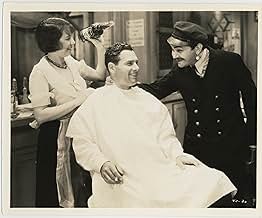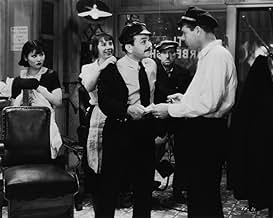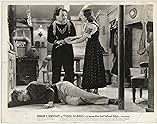IMDb RATING
6.3/10
1.2K
YOUR RATING
A tuna fisherman marries a woman who doesn't love him.A tuna fisherman marries a woman who doesn't love him.A tuna fisherman marries a woman who doesn't love him.
- Awards
- 2 wins total
J. Carrol Naish
- Tony
- (as J. Carroll Naish)
Sheila Bromley
- 'Red'
- (uncredited)
Wong Chung
- Chinese Laundryman
- (uncredited)
Edwin Maxwell
- Doctor
- (uncredited)
Toshia Mori
- Oriental Lady Barber
- (uncredited)
Henry Otho
- Crewman
- (uncredited)
Inez Palange
- Mike's Neighbor
- (uncredited)
Pedro Regas
- Crewman
- (uncredited)
Joe Roig
- Undetermined Secondary Role
- (uncredited)
Hector V. Sarno
- Crewman
- (uncredited)
Harry Semels
- Crewman
- (uncredited)
Featured reviews
Exciting film about a love triangle on the Monterey coast with Edward G. Robinson and Richard Arlen best friends and tuna fishermen. Robinson falls for bad girl Zita Johann who of course falls for handsome Arlen. Familiar storyline but Robinson is excellent as the Portuguese fisherman who battles the sea and the sharks to make a living. Arlen was a so-so actor but very handsome, and Johann had a strange exotic look. She's best remembered for The Mummy with Boris Karloff. Vince Barnett is funny and J. Carroll Naish has one scene. Leila Bennett plays a barber for some reason with pretty Toshio Mori as her assistant. Inez Palange plays a neighbor. Good film all around. But the highpoint is the truly remarkable footage of tuna fishing in a stormy sea.
Sorry, I forgot to add a point to my comment that was rather an important one, at least to me. Tiger Shark was shot in the early 1930s and there are some interesting scenes of men sailing their boat into a school of tuna, guided by a lookout, then lining up in the leads and pulling the fish in using flexible poles, one at a time. The scenes are authentic and exciting. Alas, they are history. Tuna fisherman now use "long lines." (Koreans and Japanese have huge industries built around this technique.) The fishing boat now needs a smaller crew (less expensive) because there no longer any mano a mano contests between fish and man. The crew simply strings out long fishing lines, guided by sonar, more than a mile long, with baited hooks fixed to the lines at short, regular intervals, set for a given depth. This has proved far more lucrative than fishing exclusively for tuna with poles. The long lines have a tendency to clean everything that swims out of the sea; not just tuna but sharks, sea turtles, porpoises, and game fish like marlin (which can't be legally sold). By the time they are harvested, many of the animals are already dead, especially the air-breathing turtles and porpoises. The industry has become much more efficient and without passion. Mike probably wouldn't have approved but the organization that would now own his boat would have.
Tiger Shark (1932)
*** (out of 4)
A lonely fisherman (Edward G. Robinson) marries a girl out of pity only to see her fall in love with his best friend. Director Howard Hawks does a very good job at showing off a wide range of emotions from sentiment to laughs to some very intense shark attack scenes. Robinson clearly steals the show with his touching performance but the supporting roles are good too. Another highlight is seeing the old time assembly line of having the fish removed from the boat and cleaned all in the matter of minutes. Apparently Warner loved this story so much that they remade it three times within the next ten years including Robinson returning in Manpower.!!!
*** (out of 4)
A lonely fisherman (Edward G. Robinson) marries a girl out of pity only to see her fall in love with his best friend. Director Howard Hawks does a very good job at showing off a wide range of emotions from sentiment to laughs to some very intense shark attack scenes. Robinson clearly steals the show with his touching performance but the supporting roles are good too. Another highlight is seeing the old time assembly line of having the fish removed from the boat and cleaned all in the matter of minutes. Apparently Warner loved this story so much that they remade it three times within the next ten years including Robinson returning in Manpower.!!!
I had once taped this one off Italian TV (during a lengthy Howard Hawks season of films shown in English but with Italian subtitles) but my VCR developed a fault and the recording was subsequently unwatchable! I sure am glad to have caught up with it now
First of all, Edward G. Robinson is the whole show here: his portrayal of the central character, a Portuguese fisherman who sees himself as the best in the business and speaks in amiable broken English (his catchphrase is: "Absolutely indeed") is first-rate and it was also quite funny to watch him sporting an earring. The plot is predictable enough (a woman comes between two best friends and the situation is resolved through tragedy) but that may be because the same elements were recycled so many times, even by Warner Bros. themselves, over the years: SLIM (1937), THE WAGONS ROLL AT NIGHT (1941), Raoul Walsh's MANPOWER (1941; with Marlene Dietrich coming between Edward G. Robinson and George Raft), etc.
Even more importantly, however, the imprint of director Howard Hawks is all over it: the vivid recreation of a man's world, the bonds which grow stronger through the everyday adversity which that entails, the invasion of a woman into this enclosed world which sets about the inevitable tragedy, etc. In fact, the brotherly (or even father-son) relationship seen here between Robinson and his younger protégée, Richard Arlen, is reprised in many another Hawks film Pat O'Brien and James Cagney in CEILING ZERO (1935), Thomas Mitchell and Cary Grant in ONLY ANGELS HAVE WINGS (1939), Walter Brennan and Humphrey Bogart in TO HAVE AND HAVE NOT (1944), John Wayne and Dean Martin in RIO BRAVO (1959), etc; the unceremonious intrusion of the female character onto a perfectly ordered way of life is also seen enacted by Katharine Hepburn in BRINGING UP BABY (1938), Jean Arthur in ONLY ANGELS HAVE WINGS, Barbara Stanwyck in BALL OF FIRE (1941), Lauren Bacall in TO HAVE AND HAVE NOT, Joanne Dru in RED RIVER (1948), Margaret Sheridan in THE THING FROM ANOTHER WORLD (1951), Angie Dickinson in RIO BRAVO, Elsa Martinelli in HATARI! (1962) and Paula Prentiss in MAN'S FAVORITE SPORT? (1964); early on, the "boys" in TIGER SHARK are gathered around drinking and singing to their hearts' content a similar instance occurs also in ONLY ANGELS HAVE WINGS, RIO BRAVO and HATARI! Besides Robinson's performance and the fascinating early look at the Hawksian themes elaborated on more fully in his later films, TIGER SHARK is also notable for its exciting fishing sequences especially the rather grisly (for their time) shark attacks; the scene where Robinson loses his hand to one of the marauding beasts is particularly effective.
Actually, this viewing of TIGER SHARK has reminded me of several notable films which Robinson appeared in around the same time but with which I'm not all that familiar having watched them only once years ago, namely TWO SECONDS (1932), THE MAN WITH TWO FACES (1934), John Ford's THE WHOLE TOWN'S TALIKING (1935), Hawks' own BARBARY COAST (1935), THE LAST GANGSTER (1937), A SLIGHT CASE OF MURDER (1938), THE AMAZING DR. CLITTERHOUSE (1938), CONFESSIONS OF A NAZI SPY (1939), THE SEA WOLF (1941) and MANPOWER!
Even more importantly, however, the imprint of director Howard Hawks is all over it: the vivid recreation of a man's world, the bonds which grow stronger through the everyday adversity which that entails, the invasion of a woman into this enclosed world which sets about the inevitable tragedy, etc. In fact, the brotherly (or even father-son) relationship seen here between Robinson and his younger protégée, Richard Arlen, is reprised in many another Hawks film Pat O'Brien and James Cagney in CEILING ZERO (1935), Thomas Mitchell and Cary Grant in ONLY ANGELS HAVE WINGS (1939), Walter Brennan and Humphrey Bogart in TO HAVE AND HAVE NOT (1944), John Wayne and Dean Martin in RIO BRAVO (1959), etc; the unceremonious intrusion of the female character onto a perfectly ordered way of life is also seen enacted by Katharine Hepburn in BRINGING UP BABY (1938), Jean Arthur in ONLY ANGELS HAVE WINGS, Barbara Stanwyck in BALL OF FIRE (1941), Lauren Bacall in TO HAVE AND HAVE NOT, Joanne Dru in RED RIVER (1948), Margaret Sheridan in THE THING FROM ANOTHER WORLD (1951), Angie Dickinson in RIO BRAVO, Elsa Martinelli in HATARI! (1962) and Paula Prentiss in MAN'S FAVORITE SPORT? (1964); early on, the "boys" in TIGER SHARK are gathered around drinking and singing to their hearts' content a similar instance occurs also in ONLY ANGELS HAVE WINGS, RIO BRAVO and HATARI! Besides Robinson's performance and the fascinating early look at the Hawksian themes elaborated on more fully in his later films, TIGER SHARK is also notable for its exciting fishing sequences especially the rather grisly (for their time) shark attacks; the scene where Robinson loses his hand to one of the marauding beasts is particularly effective.
Actually, this viewing of TIGER SHARK has reminded me of several notable films which Robinson appeared in around the same time but with which I'm not all that familiar having watched them only once years ago, namely TWO SECONDS (1932), THE MAN WITH TWO FACES (1934), John Ford's THE WHOLE TOWN'S TALIKING (1935), Hawks' own BARBARY COAST (1935), THE LAST GANGSTER (1937), A SLIGHT CASE OF MURDER (1938), THE AMAZING DR. CLITTERHOUSE (1938), CONFESSIONS OF A NAZI SPY (1939), THE SEA WOLF (1941) and MANPOWER!
Edward G. Robinson is Mike, a Portugese immigrant who makes his living as a fisherman in "Tiger Shark," a 1932 movie also starring Richard Arlen and Zita Johann.
Mike loses his hand while trying to save Quita's (Johann's) father from a shark, but he does manage to save his buddy Pipes. He falls in love with Quita when they meet, and, seeing that she is alone, he eventually proposes. She accepts but says that she does not love him.
He apparently doesn't notice that one of his mates, Pipes,(Richard Arlen) has a crush on Quita, so Pipes is around a lot.
This is a very dated and movie with stiff performances from everyone but Robinson. The character of Mike is very stereotypical now, but probably wasn't back then - the paunchy immigrant, kind of dumb, with false bravado, and don't forget about the hook for a hand. Very similar to "They Knew What They Wanted."
There are endless scenes of fishing, which these men did with poles and harpoons, not nets. It looked dangerous, and I guess if Quita's father died and Mike lost his hand, it was.
The pretty Roumanian actress Zita Johann, who was married to John Houseman, is effective as Mike's shy, young and grateful bride - but after she spots handsome Pipes, she realizes gratitude can only take one so far.
Here she's dressed plainly with little makeup - but one can see that with the Dorothy Lamour treatment, she probably looked very exotic.
Arlen, of "Wings" fame, is pretty hunky. He died in 1978 and worked practically until his last breath, giving him a career span of 57 years. His heyday, however, was in the silent era.
Edward G. Robinson is excellent as always, but the film just doesn't hold up today. Robinson proved early on that he could do just about anything, though in the '30s, he was most often cast as a thug.
When you see Mike in action toward the end of the movie, you'll realize this role isn't that far from what he did as Little Caesar.
I can't really recommend this unless you're interested in fishing circa 1932.
Mike loses his hand while trying to save Quita's (Johann's) father from a shark, but he does manage to save his buddy Pipes. He falls in love with Quita when they meet, and, seeing that she is alone, he eventually proposes. She accepts but says that she does not love him.
He apparently doesn't notice that one of his mates, Pipes,(Richard Arlen) has a crush on Quita, so Pipes is around a lot.
This is a very dated and movie with stiff performances from everyone but Robinson. The character of Mike is very stereotypical now, but probably wasn't back then - the paunchy immigrant, kind of dumb, with false bravado, and don't forget about the hook for a hand. Very similar to "They Knew What They Wanted."
There are endless scenes of fishing, which these men did with poles and harpoons, not nets. It looked dangerous, and I guess if Quita's father died and Mike lost his hand, it was.
The pretty Roumanian actress Zita Johann, who was married to John Houseman, is effective as Mike's shy, young and grateful bride - but after she spots handsome Pipes, she realizes gratitude can only take one so far.
Here she's dressed plainly with little makeup - but one can see that with the Dorothy Lamour treatment, she probably looked very exotic.
Arlen, of "Wings" fame, is pretty hunky. He died in 1978 and worked practically until his last breath, giving him a career span of 57 years. His heyday, however, was in the silent era.
Edward G. Robinson is excellent as always, but the film just doesn't hold up today. Robinson proved early on that he could do just about anything, though in the '30s, he was most often cast as a thug.
When you see Mike in action toward the end of the movie, you'll realize this role isn't that far from what he did as Little Caesar.
I can't really recommend this unless you're interested in fishing circa 1932.
Did you know
- TriviaQuita wears traditional Portuguese attire for her wedding.
- GoofsWhen Quita tells Mike to leave her alone after being informed of her father's death, he responds twice with "yeah, all right". But Robinson as Mike drops the Portuguese accent he uses for the role and uses a regular American accent.
- Crazy creditsOpening Card: San Diego
- ConnectionsFeatured in Sharksploitation (2023)
- SoundtracksAbdulla Bulbul Amir
(1877) (uncredited)
Written by William Percy French
Sung by Richard Arlen and members of the crew
Details
- Release date
- Country of origin
- Languages
- Also known as
- Tiger Shark
- Filming locations
- Monterey, California, USA(outdoor sequences)
- Production company
- See more company credits at IMDbPro
- Runtime
- 1h 17m(77 min)
- Color
- Sound mix
- Aspect ratio
- 1.37 : 1
Contribute to this page
Suggest an edit or add missing content




































